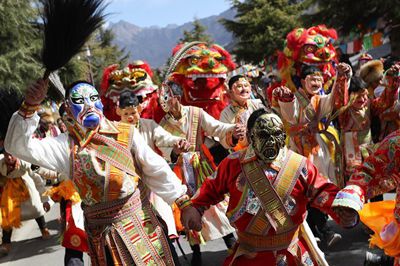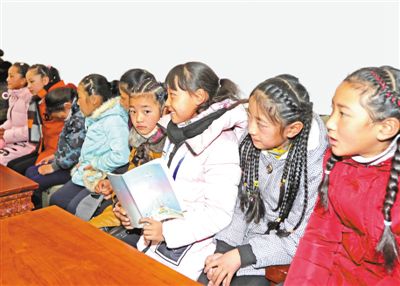Autonomous Regional Committee of the CPC. I remembered in a reception for two American guests in Lhasa Holiday Inn, the two asked Lhagpa Phuntshogs many biased questions on the population, women and children, modern history, and financial situation of monasteries in Tibet. Lhagpa Phuntshogs answered each question with assurance by citing historical evidence, winning the consent of the two Americans. Upon leaving, they said to Lhagpa Phuntshogs, "we see a real Tibet in you". After I moved to the office of the Publicity Department of Tibet Autonomous Regional Committee of the CPC, I got familiar with Lhagpa Phuntshogs as his neighbor. Amid warm applause, two urn-guardian lamas, holding the edge of their robes in their mouths, carried the gold urn in reverence and deference onto an altar covered by an auspicious tablecloth. The practice of holding the edge of their robes in the mouth was to prevent the holy urn being polluted by the exhaled air of the urn-guardian lamas. I did not feel surprised when I saw lamas all holding the edge of their robes in their mouths in full reverence when serving the 11th Panchen Lama. The gold urn dazzled in the flickering light of cameras and video cameras. IV. Origin of the system of drawing lots from a gold urn The gold urn, also called "gold Benba urn", was specially made by the central government of the Qing Dynasty in 1792, or the 57th year of Emperor Qianlong's reign, for drawing lots to determine the reincarnated soul boys of the Grand Living Buddhas above the Hutuktu rank. The urn contained five ivory lots of the same size. According to historical records, the urn was 34 cm tall, weighs 2.85 kg, and was 12 cm in caliber and 21.3 cm in diameter. It is a cultural relic under priority protection at the national level. The system of drawing lots from a gold urn to determine reincarnated soul boys of the highest rank of Living Buddhas was officially instituted in 1792 under the Emperor Qianlong's reign. After the introduction of the lots-drawing system, three Panchen Lamas and six Dalai Lamas were confirmed. Some 70 Living Buddhas in Tibetan Buddhism were determined through the process of drawing lots from the gold urn. Although the Tibetan Buddhism had a long history, it had stable characteristics at the very beginning. I once mentioned in an article that the Tibetan Buddhism had two features: namely, its essence was inherited from Sakyamuni Buddhism doctrines, while its framework was from old Bon-pa in Tibet. During the period from Emperor Kangxi's reign to Qianlong's reign, there were conflicts among various religious sects in Tibet. The Mongolian Khan and local authorities tried every means to control the Grand Living Buddha in Tibet, so as to expand their power and |
- Home
- News |Tibet |Exclusive |China |World |Other Tibetan-Inhabited Area |Tibet through the Eyes of Foreigners |Related News
- Documents |White Papers |Others
- Photo |Politics |Economy & Society |Culture & Religion |Human & Nature |Beautiful Tibet |Other Tibetan-Inhabited Area |Exchanges |Related
- Video |News |Documentary |Micro-Video |Entertainment
- Art
- Tourism
- In Focus
- About Tibet






